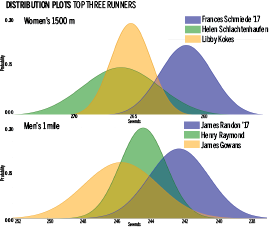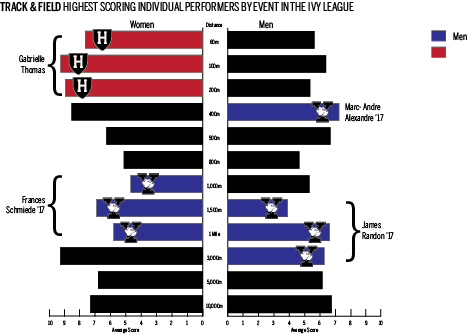
On Feb. 15, the Yale Undergraduate Sports Analytics Group published an analysis of Ivy League swimming performance . We argued that given the variability of times race-to-race, running simulations — rather than taking just the raw results — could give a better indication of the best swimmers in the Ivy League.
The same reasoning can be applied to men’s and women’s track. We considered all the races of the 2016 and 2017 seasons for indoor and outdoor track. For each runner in the Ivy League, we computed the mean and variance of their times for each event and pitted them against each other in a theoretical eight-team meet.
While a real meet occurs once and leaves much to chance, our meet was simulated 10,000 times. Following the standard practice for eight-team meets, 10 points were awarded for a first-place finish, eight for second, six for third and one less for each further subsequent place down to one point for eighth. After 10,000 simulations, we produced an average score for each runner in each event.
The first chart shows the scores for the top women’s athlete in each event. A higher average score indicates less parity within the event, since the conference leader takes high marks a higher percent of the time.

Two runners, Harvard’s Gabrielle Thomas and Yale’s Frances Schmiede ’17, take the top score in three events, with Schmiede leading the Ancient Eight in the middle-distance events. Her main competition is Dartmouth’s Helen Schlactenhaufen, without whom the Yale senior would also have taken the 800-meter crown.
The relatively low height of the 800- meter and 1,000- meter bars indicate that these are the most competitive events in the Ivy League. Thomas, on the other hand, faces far less competition in the sprint events, a distance at which an area in which Yale track has not enjoyed as much success.
The men’s chart shows a bit less individual dominance, with the average score falling below eight for each event. In contrast to the women’s team, the Yale men’s side has two dominant sprinters in Vincent Vaughns ’20 and captain Marc-André Alexandre ’17. Alexandre’s average score in the 400 meters is the highest of any male runner in any event. Yale’s James Randon ’17, meanwhile, takes the top score in three events: the mile, the 1,500 meters and the 3,000 meters.
We can take a closer look at Randon’s competition in the mile by plotting the distribution of times for the top three runners in the event. Though followed by Cornell’s James Gowans and Dartmouth’s Henry Raymond atop the conference, Randon is well separated from the rest of the group. Based on these distributions, Randon would beat Raymond in the mile 72 percent of the time and Gowans 73 percent of the time.
The distribution plot for Schmiede in her best event, the 1,500 meters, displays even more separation from her two most imposing competitors. Notably, Schlactenhaufen’s average score in this event exceeds Kokes’, even though Kokes has a faster average time.
Schlactenhaufen’s greater variance allows her to take advantage of a scoring system which disproportionately rewards top three finishes. Even on good days, however, Kokes still runs the 1,500 meter considerably slower than Schmiede’s average, predicting that Schmiede would beat Kokes in 85 percent of 1,500-meter races.
The Bulldogs will host the Ivy League Outdoor Heptagonal Championship meet at DeWitt-–Cuyler Field complex on May 6–7.







